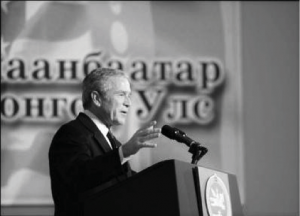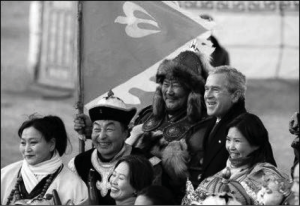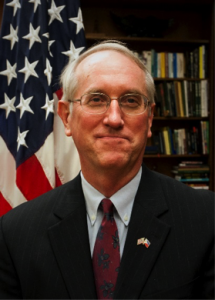by Pamela J. Slutz and Brian L. Goldbeck
Editor’s note: This article is adapted from a longer piece published in Volume 38 of the Journal of the Mongolia Society: http://mongoliasociety.org/publications/. (Note: The text of Volume 38 will soon be available on the JSTOR website: https://www.jstor.org.) The authors, Pamela Slutz and Brian Goldbeck, were U.S. Ambassador to Mongolia and Deputy Chief of Mission during the historic visit of President George W. Bush.

President George W. Bush’s November 2005 visit to Mongolia marked an important milestone in U.S.-Mongolia relations. When the two countries established diplomatic relations in 1987 after many years of Cold War frostiness, Mongolia was a communist country closely allied to the Soviet Union.Bush’s visit, the first by a sitting U.S. president, re-affirmed Mongolia’s transformation from communism to democracy and a free market economy.
In September 2005, the embassy was advised of a “possible POTUS visit” in late November and was instructed to approach the Mongolian government to determine whether it would welcome the President’s visit. The answer was an enthusiastic “YES” from Mongolia’s government.
The negotiations that accompany all presidential visits began. Initially, Mongolia proposed three formal meetings: with then-President Nambaryn Enkhbayar, then-Prime Minister Tsakhiagiin Elbegdorj and the Cabinet, and the Speaker and members of Mongolia’s unicameral legislature, the Ikh Khural. Noting the limited four-to-five-hour time block for the entire visit, the White House lead countered by requesting a separate meeting with the Prime Minister that would segue into a “meet and greet/photo op” with members of the coalition Cabinet, and a brief “meet and greet/photo op” with the Speaker of Parliament.
The White House’s priority was to ensure sufficient time – and a suitable venue — for Bush to make a major policy speech to a broad audience of Mongolians. Mongolia wanted President Bush to give his speech in the Parliament chambers as had other visiting leaders from China, Russia, etc. The Parliament, however, would not fit the White House’s desired audience of several hundred for President Bush’s main policy speech for the trip. After suggestions that the visit might be canceled if a suitable venue was not available, the Mongolian representatives agreed that the Government House’s conference hall could be used. Add to this a half-dozen pull aside photo opportunities including Bush’s cousin and the parents of a soldier killed in Iraq among others.
Ultimately, over 400 Mongolians were invited by both sides, and the audience included not only officials but also soldiers (including two heroes who served in Iraq and who received medals from Secretary of Defense Rumsfeld during his October 2005 visit) and their families, and prominent civil society and business leaders. U.S. attendees included First Lady Laura Bush, Secretary of State Condoleezza Rice, Ambassador Slutz, and several other high-level White House and National Security Council officials. Bush’s speech was broadcast live on national radio.

A meeting with a herder family and music and dance performances were also included, respecting Mongolian culture, though the suggestion to hold them an hour outside of town was a non-starter given time constraints. Instead, these events were planned for the Ikh Tenger leadership residence compound on the town’s south side, a venue more accessible, secure, and with fewer motorcade movements.
Bringing in Support, Solving Problems
Clearly, the embassy’s 30+ Americans and 100+ Mongolian staff would not be enough to handle a visit of this size, even one that lasted less than five hours. Throughout November, staff from U.S. missions all over Asia flocked to Ulaanbaatar to help support the visit. In total, some 400 persons helped at various times, filling three local hotels at a time when off-tourist season occupancy was normally 20-30%.
Daily count-down meetings dealt with the problems inherent in the complexities of a presidential visit. For starters, Ulaanbaatar’s airport lacked sufficient fuel storage for Air Force One and other accompanying aircraft. The solution: a larger fuel bladder was flown in from Osan Air Force Base in South Korea. But a suitable loader-lifter was not available in Ulaanbaatar to unload the bladder from the aircraft. Solution: Fly one in from Osan. Problem solved.
Post realized that it would be impractical to move all 200+ members of the President’s entourage from the airport into the downtown area, especially given that some of the event sites did not have space for even the 30 or so VIPs accompanying the President. Solution: bring information, vendors, performers, food etc. to an airport holding area. Problem solved.
Efforts to Elevate the Relationship
For the United States, Bush’s visit was the culmination of several years of work by both countries to elevate the U.S.-Mongolia relationship to that of a “Comprehensive Partnership.” The groundwork began in February 2003 when then-President Natsagiin Bagabandi, on a private visit to the United States, met with then-National Security Advisor Condoleezza Rice and President Bush “dropped by” the meeting.
The two presidents met again in July 2004 when President Bush invited President Bagabandi to a “working” visit, including a 30-minute meeting in the Oval Office, following which the two heads of state issued the July 15, 2004 Joint Statement announcing “the comprehensive partnership between their two democratic countries based on shared values and common strategic interests.” For both the U.S. and Mongolia, “shared values” meant a “commitment to democratic government and private sector-led free market economics.” By “common strategic interests” the two partners meant peace and stability—in “volatile” Northeast Asia in particular, East and Central Asia by extension, and the world writ large in principle.
For the U.S., a presidential visit would serve to highlight support for Mongolia’s transformation from communism to democracy and U.S. appreciation for Mongolia’s independent “third neighbor” policy being landlocked and sandwiched between China and Russia, including its commitment to spread democracy and combat terrorism.
For Bush himself, the visit appeared to be as much for personal as foreign policy reasons. In a scene setter interview with (Mongolian) Eagle Television, Bush explained his interest in coming:
“…Mongolia has a certain fascination for me. I grew up in the West of the United States where we like wide-open spaces. And when you think about Mongolia, you think about a big country with a lot of space.
But what’s interesting about Mongolia is it’s more than geography now, as far as I’m concerned. It’s a people that have worked hard to become free, a democracy. We kind of consider ourselves—and we like the slogan, “the third neighbor” of Mongolia. And so, I’ve chosen to go there because of the spirit of the people and a leadership that shares our desire to have a government of and by and for the people.”
Bush went on to thank Mongolia for its contribution of peacekeeping troops in Iraq and Afghanistan and to welcome the ongoing negotiations on a Millennium Challenge Compact.
Symbol of Partnership
For the Mongolians, the proposed visit by the President of the United States symbolized—and was interpreted as a symbol of—the importance with which the United States regarded its relationship with Mongolia. As a “partner” of the U.S., Mongolia became a respected “equal” on the global stage.
In a pre-visit Washington Post op-ed entitled “Mongolia: Moving Mountains,” Mongolian Prime Minister Tsakhiagiin Elbegdorj emphasized Mongolia’s commitment to democracy, a private sector-led free-market economy, and “standing shoulder to shoulder with its U.S. and coalition colleagues to create free societies and fight terrorism in Iraq and Afghanistan.” He opened with:
“Mr. President, welcome to Mongolia. Welcome to freedom. Those are the words with which I will greet President Bush when he arrives in Mongolia today. They represent an extraordinary odyssey for my country, one that has taken us from totalitarianism to free-market democracy in just 15 years.”
He also welcomed Mongolia’s eligibility for a Millennium Challenge Corporation (MCC) grant or Compact5: “When we sign our [five-year] compact it will add a new level of transparency and public participation in this critical poverty alleviation program.”
Progress Toward Democracy and Peacekeeping
During the year leading up to Bush’s visit—long before the visit was announced—numerous high-level visits in both directions continued the momentum toward a closer relationship, including the first-ever visits to Mongolia by a Speaker of the House (Dennis Hastert) and Secretary of Defense (Donald Rumsfeld).
Speaker Hastert’s visit focused on U.S. support for Mongolia’s democratic transformation, specifically Mongolia’s inclusion in what was to become the House Democracy Partnership. Secretary Rumsfeld’s visit focused on U.S. support for the transformation of the Mongolian Armed Forces into an international peacekeeping force and its contribution to the global war on terrorism, specifically, Mongolia’s commitment of 190 peacekeepers to the Multinational Force in Iraq. Since the mid-1990s, the U.S. had provided military assistance to enable Mongolia to transform its armed forces into an international peacekeeping force. By 2003, Mongolian peacekeepers were serving on several UN missions and by 2005, its “Five Hills” army base outside of Ulaanbaatar had been transformed into a regional peacekeeping training center which, with U.S. support, conducted the annual multinational Khaan Quest peacekeeping exercise.
Mongolia also became the first Asian country (and one of only 17 countries worldwide) in 2004 to be “invited” by the newly created U.S. Government Millennium Challenge Corporation (MCC) to enter into negotiations with the MCC on a Compact (of projects) designed to achieve sustainable economic growth and poverty reduction.
Negotiating the Outcomes
A presidential meeting has a way of forcing bureaucracies to resolve outstanding issues BEFORE the visit so they won’t be on the summit agenda. Two issues emerged as “problematic.” First, Mongolia wanted to conclude a bilateral Free Trade Agreement with the U.S., but given long-standing bipartisan constraints imposed by the Congress, the Bush administration could not agree to pursue one. As preparations for President Bush’s visit proceeded, the Bush Administration sent strong signals to the Mongolian side that this was not going to happen – certainly not during the President’s visit. So, while both President Enkhbayar and Prime Minister Elbegdorj raised the issue with President Bush, they were not surprised by the negative answer.
Rather, the U.S. response was to reiterate the importance of proceeding step-by-step toward a Free Trade Agreement, beginning with the Trade and Investment Agreement (TIFA) that had been signed during President Bagabandi’s July 2004 visit to Washington. The TIFA created a United States-Mongolia Council on Trade and Investment that was to consider a wide range of issues, including intellectual property rights, labor, environmental matters, non-tariff barriers, investment and transparency with the goal of removing impediments to trade between the United States and Mongolia.
Second, the U.S. was concerned that persistent and growing corruption in the public sector in Mongolia was undermining the Mongolian people’s confidence in their leaders, in democracy, and in economic reform. Further, Mongolia’s declining score on the anti-corruption test of eligibility for the Millennium Challenge Account threatened to “suspend” the negotiations on a compact.
Mongolia’s parliament ratified the UN Convention Against Corruption in October, but had not yet passed the legislation necessary to implement Mongolia’s commitments by the November visit. In his meetings and public speech, Bush urged parliament to pass the anti-corruption legislation needed to implement the UN Convention —which parliament ultimately did.
Both countries heralded President Bush’s precedent-setting visit as a success. Mongolia’s sovereignty, transformation from communism to democracy and a free market economy, and status as a regional and global player of consequence were re-affirmed by a major “third neighbor.” Mongolia’s contributions to international peacekeeping and its commitment to spread democracy and combat terrorism were recognized and rewarded.
The visit also set the stage for further collaboration on a bilateral and global scale: the annual TIFA talks continue and in January 2017 the U.S. and Mongolia signed the Agreement on Transparency in Matters Related to International Trade and Investment. On September 20, 2018, on the occasion of the official visit of Mongolian Prime Minister Khurelsukh, the U.S. and Mongolia signed a second five-year Millennium Challenge Compact and agreed on a Roadmap for an Expanded Economic Partnership. Mongolia served as the President of the Community of Democracies from 2011-2013 and remains engaged in democracy-building globally. And, as of March 2019, over 11,000 Mongolian military personnel had served honorably in UN peacekeeping missions around the world.
Significantly, Presidents Donald J. Trump and Battulga Khaltmaa issued a formal statement following their July 31, 2019 meeting in Washington, D.C., in which “The governments of the United States of America and Mongolia hereby declare their relationship to be a Strategic Partnership.” In Mongolia, the elevation of the bilateral relationship with the United States from “comprehensive” (2004) to “strategic” (2019) was touted as a vindication of the utility of its “third-neighbor policy:” the United States joined Russia (2006), Japan (2010), China (2014), and India (2015) as a formal “strategic” partner of Mongolia. For the United States, awarding Mongolia the status of “strategic” underscored the continuing importance of Mongolia as a key partner in the U.S. vision of a “Free and Open Indo-Pacific” region. ![]()

Ambassador Slutz served as U.S. Ambassador to Mongolia from 2003-2006. During her 32-year career as a U.S. Foreign Service Officer, she served extensively in Southeast and East Asia and in Africa. Following her retirement in 2012, she served as Chairman of the North America-Mongolia Business Council (2013-2016) and is currently the President of The Mongolia Society, a non-profit organization established in 1961 and dedicated to promoting the study of Mongolia. (http://mongoliasociety.org/)

Brian Goldbeck joined the U.S. State Department in 1983 and retired in 2015 as a career member of the Department’s Senior Foreign Service. He served as the Deputy Chief of Mission at U.S. Embassies in the Philippines, Mongolia, and Ethiopia. He was the U.S. Consul General in Guangzhou, China, served as Embassy Seoul’s Political Section Deputy, and as an Economic Officer in Hong Kong and Beijing as well as Sanaa, North Yemen; he also served as the State Department’s World Bank liaison. He served 28+ years in the Army/Reserves including as a China Foreign Area Officer.
